Miller Function & Participation Scales (M-FUN-PS) Review
The Miller Function and Participation Scales (M-FUN-PS) is a standardised developmental assessment for children aged 2 years and 6 months, to 7 years and 11 months. It covers three motor domains: visual motor (VM), fine motor (FM), and gross motor (GM), as well as participation. The M-FUN-PS was authored by Dr Lucy Miller, a very experienced occupational therapist and researcher. Dr Miller has done a lot of work in the area of sensory processing disorder (SPD), and has founded the SPD Foundation, the STAR Centre for SPD treatment, and the SPD University, which provides online education to caregivers, the community, and health professionals. The M-FUN-PS was published by Pearson Clinical in 2006, and can be purchased through the Pearson website.

I've been using the M-FUN-PS (or M-FUN for short) for about 18 months. We decided to purchase the M-FUN as a replacement for our old Peabody Developmental Motor Scales, which had pieces missing and included some rather out-dated activities (which some may call "classic", but we were finding children commonly found test materials unfamiliar). We wanted an assessment that could provide detailed results for parents and teachers, with the child's transition to school in mind. The main purpose for this assessment in my setting has been to prepare for or assist the child's transition to their first year of formal schooling ("Prep" in Queensland).
The M-FUN is split into two age levels, 2yrs 6mths until the child turns 4, then 4yrs until the child turns 8. As transition to school occurs in Queensland between 5yrs 6mths and 6yrs 6mths, I have never administered the younger version of the assessment.
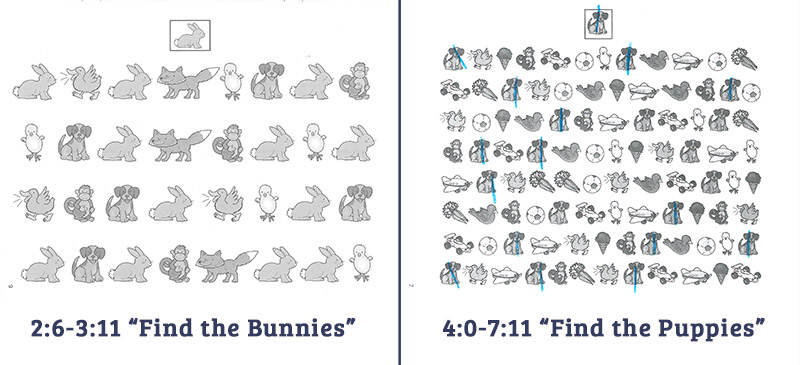
The two age groups complete the same items, with the tasks simplified accordingly for the younger group.
In my opinion, it's quite a long and detailed assessment to consider administering with such a young age group, particularly with children who have developmental delays. Even the younger version includes letter writing, which I would consider to be developmentally beyond that age group.

The workbooks and examiner forms are different for the lower and upper age ranges. The covers and layout are very motivating for children.
The M-FUN kit includes many motivating and familiar items for children. The manipulatives (below) come with the M-FUN set, or you can put together your own set by following the list in the assessment manual. We found that we needed to replace some of the included items with locally sources items, which worked better. For example, the "soft modelling clay" included in our kit was rock hard, and even the therapists had trouble moulding it. We have replaced it with standard plasticine.
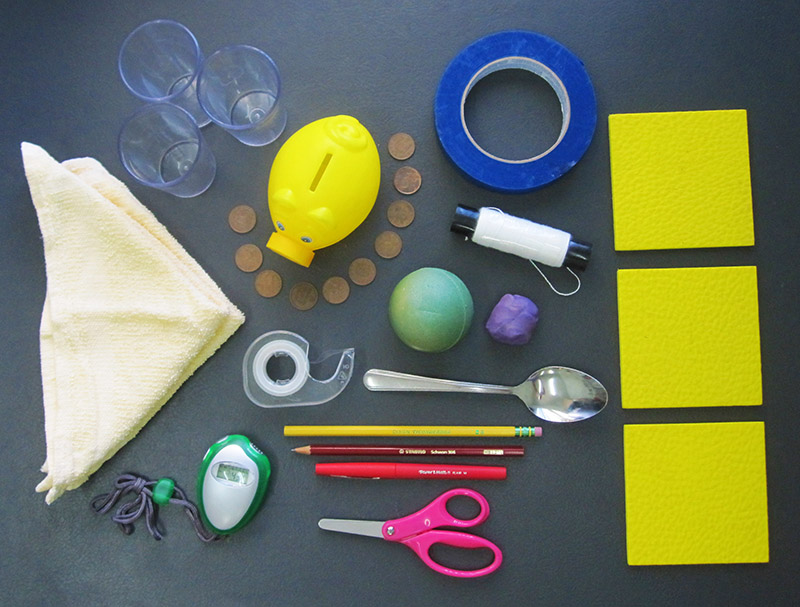
The M-FUN domains (Visual Motor, Fine Motor, and Gross Motor) are made up of multiple games each. Each game is like a subtest all of its own, except the standard scores are only available when scoring for every game of the domain is completed. Here is the raw score table from the Examiner Form, which shows the games under each section:
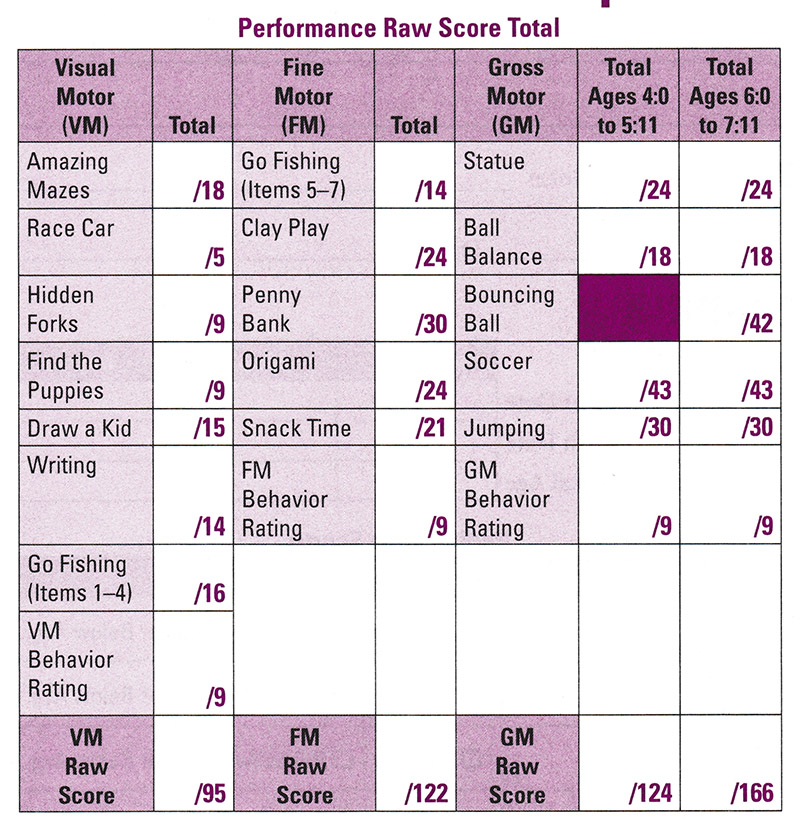
Let's simulate one game from the fine motor domain to give you an idea of how the assessment is administered. The game I've chosen is one that I find particularly challenging to administer. Not all items are this complex.
The Origami Game
To prepare: Before the assessment session, you have removed the middle page of the child's workbook and cut out the two origami templates. You also have your own origami templates, to use as a demo.
You have on hand: the administration directions, the examiner record form, two terry towelling washcloths, your demo origami templates, the child's origami templates, and a stopwatch.
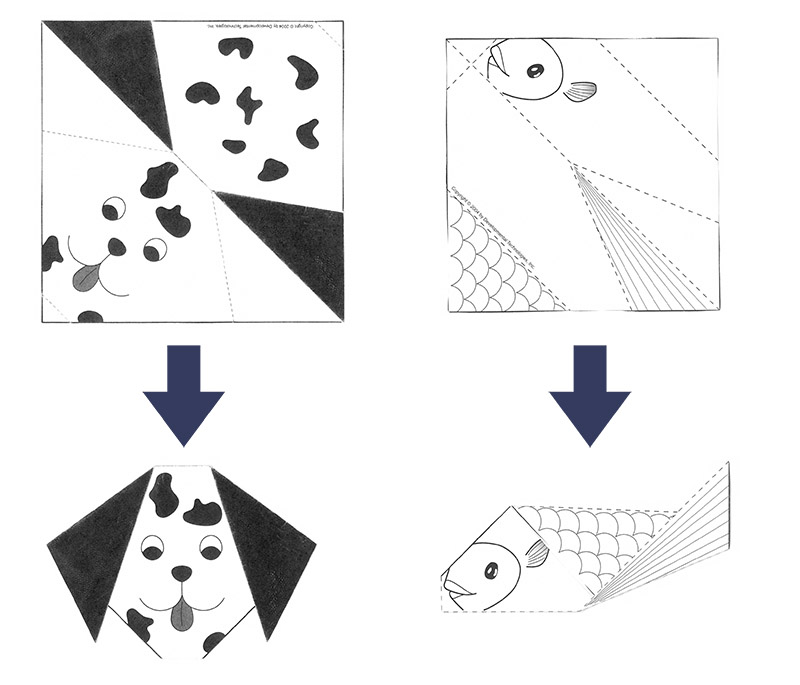
Origami items for 4-7 year olds.
Administer the items: Following the wording in the administration directions (below), you complete the practice item with the child using the washcloths, followed by the dog origami, and the fish origami.
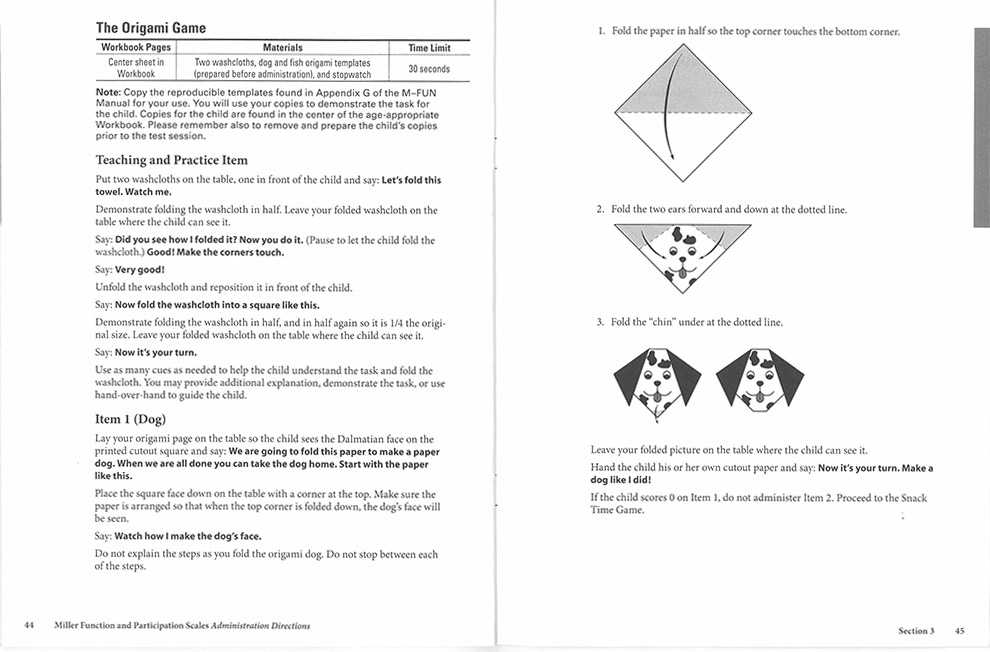
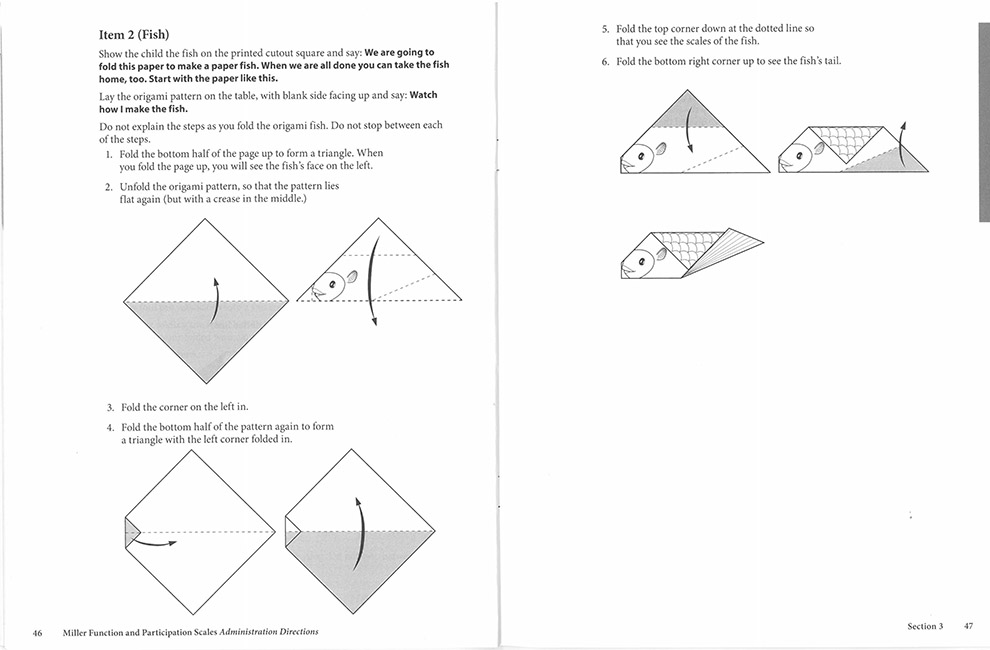
Scoring: Now, I hope you were paying attention to the child's hand use and to the 30 second time limit. Work done after the time limit doesn't count. Here is the scoring to complete:
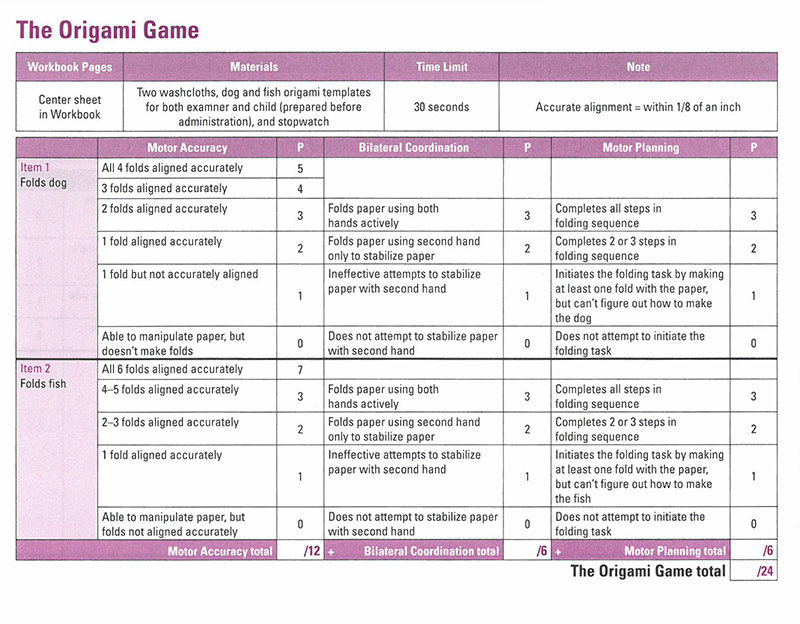
Once you've finished all items in the 25 page Examiner Form (below), you can score it all up and get standardised scores for each of the three "Performance" domains, and use the examiner form and the manual to decide whether the child is performing at an age-appropriate level, or whether the child's skill development is delayed.
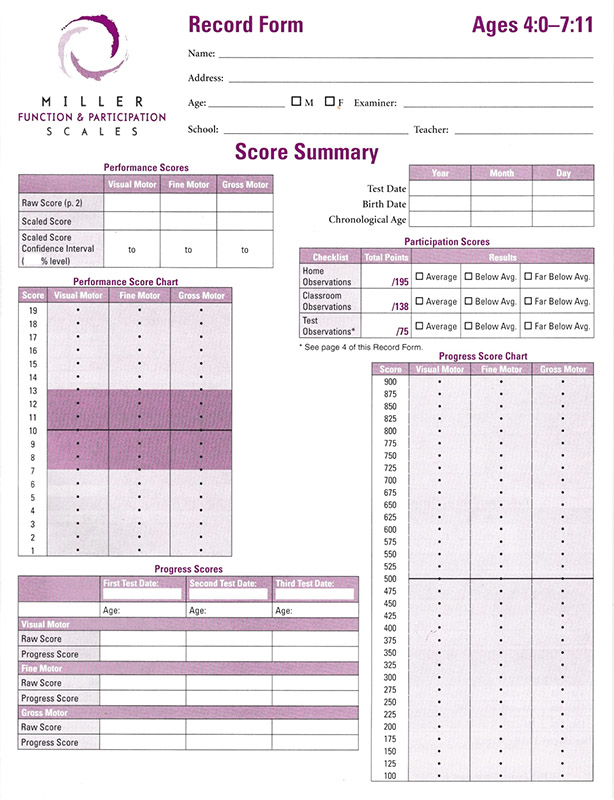
Examiner Form for the upper age group
You can collect back the Home Observations Checklist from a parent, and the Classroom Observations Checklist from the teacher, and compare the results to your Test Observations Checklist. I believe these checklists are the same for both age groups. These provide the measure of "Participation".
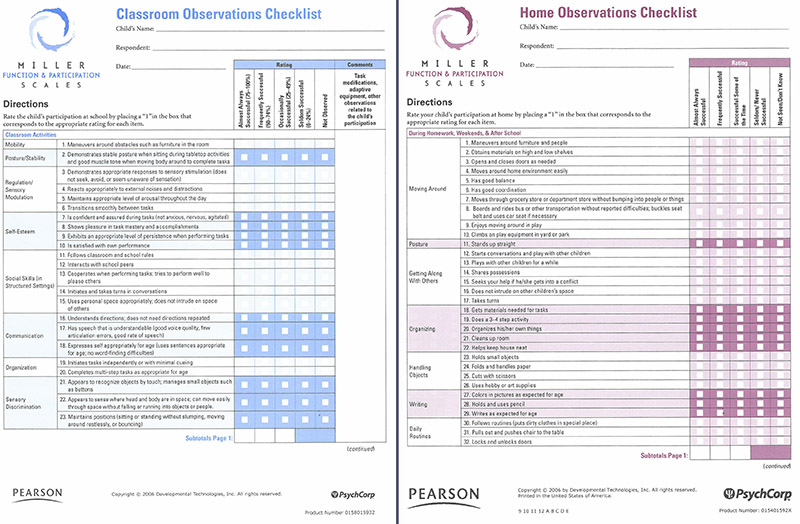
Now that you've had a taste of how the M-FUN is administered, let me share my experiences in using it.
Things I Like:
- The assessment appeals to children. It is actually fun, as it was designed to be.
- It gives you LOTS of information about the child's physical development and function. The Neurological Foundations profile allows the examiner to perform deeper analysis of the child's function, which can be particularly helpful for intervention planning.
- It is more holistic than other, similar assessments that concentrate solely on clinical acquisition of motor abilities. The scores on the observations checklist can provide an indication as to how poor motor performance affects their participation in the home and class settings. Again, this is very helpful for intervention planning.
- The parts can be used separate from the whole assessment. For example, I can still get standardised results for a child's VM and FM without doing the GM component or observation checklists.
- It covers all the basic skills I want to check for a child entering school, such as visual scanning and tracking, pencil control, scissor skills, ability to sit at a table for a length of time (45min), and following instructions.
Things I Find Difficult:
- While theoretically, this assessment can be done in a variety of settings (clinic, home, school, etc.), this isn't always easy. I have found the gross motor section difficult, as it requires prior set-up of measured lines and markers, and it requires a smooth wall with a concrete floor against which a ball can be kicked for "Soccer". I've been unable to locate an appropriate wall at several locations (homes and schools).
- If one item in a performance domain can't be completed, a standard score for the domain cannot be calculated. Therefore, if the only suitable wall becomes unavailable (e.g. it starts raining) for the Soccer game, a standardised GM score can't be obtained even for the upper body items, and the time you've spent on the rest of the GM section becomes much less useful.
- To administer this assessment, you have to be very organised. As you may have noticed in the Origami example above, there are many different resources to juggle, and the examiner's attention is constantly split between observing the child, checking the administration directions, scoring ("how many fold is that? OK, four folds, but 2 weren't accurate, and maybe that beautiful final fold was after the time limit… how do I score that??"), and keeping time.
- Because the children enjoy the assessment items, they want to finish their work. I like children to finish their work too, but the time limits are very short for the children I work with, and it's very difficult to stop them half way through every single item! It's not great for rapport or for their sense of accomplishment.
- I've found it takes more preparation time than other assessments, and it takes longer to score, compared to something simpler like the DTVP-3
- It's American. For example, one of the Classroom Observations Checklist items is about whether the child can carry their tray in the cafeteria. This isn't relevant in most Australian schools. I've modified this item to be "manages lunch box independently."
Tips for Easier M-FUN Administration:
- In researching for this post, I've come across a 4 hour e-learning course by Dr Lucy Miller on using the M-FUN-PS. It's available on the SPD University website for US$185, course #2301 and #2302. I'm planning to do them soon, so I'll let you know if they're helpful.
- It helps to have two people administering the assessment together. I have done it with a physio, where we took turns between scoring/time-keeping and administering the tasks for the FM and GM sections. It's so much easier with two sets of eyes!
- Keep your M-FUN kit ready to go, stocked with everything you need, and make a short list somewhere (I wrote it in the front of the administration directions book) of the things you need to gather for each assessment (i.e. fresh crackers, water and napkins for the Snack Time item, cut out origami templates, etc.).
- If the child wants to take their handiwork with them, make sure you take a photo of it so you can double-check your scoring if you need to. If possible, video the assessment (or parts) so you can check things afterwards, particularly the first few times you administer it.
Overall, I find the M-FUN to be very useful, when a rigorous assessment is required. It is fun for the child and provides helpful information to the examiner.
See my post about M-FUN Online Learning Course
Well, there are my thoughts. What are yours? Have you used the M-FUN-PS? Please share your comments.